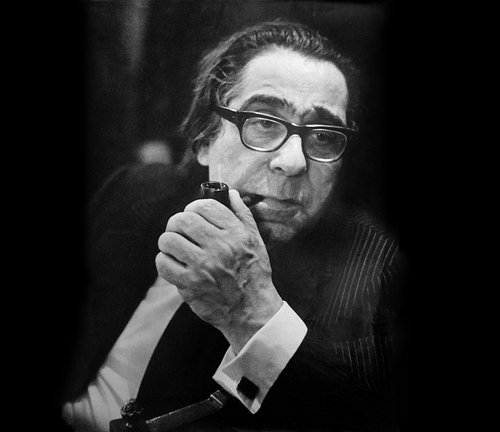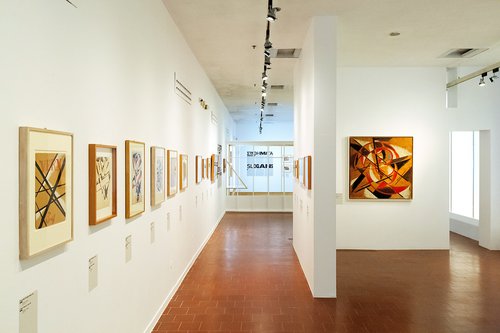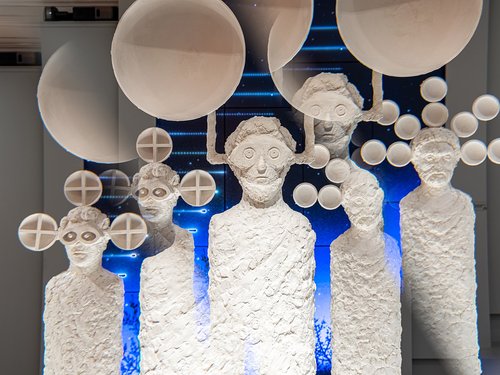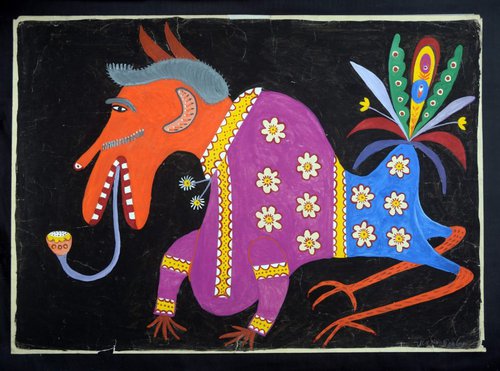Russian Collectors Shun Abstraction

Liubov Popova. Painterly Architectonic, 1918. Courtesy of Slobodskoy Museum and Exhibition Center
Around the world, abstract art has come out of its historical shadowing once behind the shine of Pop Art and more recently a millennial craze for figurative, narrative art seen across top Western auctions and art fairs. In Russia a new exhibition dedicated to pioneering Russian abstract artist Liubov Popova (1889–1924) has just opened at the Jewish Museum and Tolerance Centre in Moscow marking the centenary of her death and recognition for her achievements is at an all-time high. How does this interest in abstract painting play out among Russia’s art collectors?
Russia was one of the cradles of abstract art so do Russian collectors today nurture this valuable legacy and see themselves as anointed heirs by association with something of a deeper understanding of this art than us mortals? If you take out the phenomenon of George Costakis, a Russian of Greek parentage and the miracle of how during the late 20thcentury he single-handedly salvaged a trove of Russia’s greatest cultural assets, the short answer is no. Since the collapse of the Soviet Union, and the growth of Russian private art collecting, I have often seen figurative modernism as the love child of Russian art collecting rather than geometric abstraction.
It is well known that top Russian avant-garde abstract art is impossible for private collectors to find, both in Russia and the West, and throughout all the years I worked at Sotheby’s in the Russian art field there were few offered for sale at auction. I remember two works in particular: Liubov Popova’s ‘Still Life with Tray’ which sold for $3 million in 2007 (a record price for the artist at auction which is still unchallenged) and ‘Spherical Suprematism’ by Ivan Kliun (1873–1943) which had once belonged to George Costakis and sold for $6.2 million in 2019. They may sound like big prices but they certainly fell short of top records by figurative Russian artists like the $10million achieved for Natalia Goncharova’s ‘Les Fleurs’ of 1912, a radical paintings which nevertheless still retains clear figuration, or Kuzma Petrov-Vodkin’s ‘Still Life with Lilac’ of 1928 which fetched $11.7M at Christies in 2019.
A widespread evangelistic conversion to the forbidden fruit of formalist art never materialised among art collectors at the end of the Soviet Union when it came out of the vaults or studios having been hidden in private apartments. With perhaps the exception of Vassily Kandinsky (1866–1944) for more liberal and openminded Russian collectors who like abstract paintings and for whom the early 20th century avant-garde abstraction is an unrealistic prospect because of its sheer rareity, not to mention the widespread problem of fakes, to acquire works by the next generation of non-conformist abstract painters, like Vladimir Nemukhin (1925–2016), Lydia Masterkova (1927–2008) Evgeny Mikhnov-Voitenko (1932–1988), or works by the Dvizheniye group is surely interesting. How does this play out in reality?
Puzzlingly, there is yet to be a wholesale uptake among Russian collectors. Put more simply, abstract non-conformist painting is not popular. Looking more broadly, in terms of its market value and visibility, over the past few decades non-conformist art has remained in the shadows, as it was during the Soviet times. Today, in the West, even the term ‘non-conformist’ is little known outside small academic and collector circles and its full meaning has not been written into broader chapters of late 20th century international art history. You also just need to scroll through an online catalogue of an auction of international contemporary art at Sotheby’s or Christie’s to see that they simply do not accept works by non-conformist artists, or if they do it is a rare exception.
By the end of the 2010s the market for Russian non-conformist paintings was growing with some real confidence both in the West and in Russia. Previously, there had been a short-lived bull market around the time of the economic crisis of 2008, followed by a very slow, long drawn-out bear market where tastes stopped evolving and prices stagnated. During all those years spanning nearly two decades there was one constant: prices for figurative non-conformist paintings far outstripped those for non-conformist abstract paintings, and I think this is a trend which is continuing also today.
Evgeny Chubarov (1934–2012) still holds the record for an abstract painting by a Soviet non-conformist artist for a large-scale canvas, ‘Untitled’ sold at Phillips de Pury in 2007 for $1.3million followed, in order of descending value, by Ivan Chuikov (1935–2020), Vladimir Yankilevsky (1938–2018), Francisco Infante (b. 1943), Evgeny Rukhin (1943–1976), Vladimir Nemukhin and Lydia Masterkova all of whom are artists who worked mostly in abstraction. A quick comparison of their record prices at auction in London and New York, creates the impression that collectors internalised an unspoken ceiling of $200,000 for the purchase of an abstract painting by a non-conformist artist, impervious to the importance of the work in his or her oeuvre, a ceiling which has hardly shifted over decades.
The case of Oleg Vassiliev (1931–2013) who like his exact contemporary Gerhard Richter (b. 1932) worked solidly and intentionally with both figuration and abstraction throughout his career, at times combining them and then creating works which are either exclusively one or the other, bears this out, with most of the top prices ever achieved at auction being for works in which figurative elements reign supreme. His purely abstract large-scale masterpiece ‘Space II’ painted in 1992, sold for just $157,170 at auction in Moscow in 2020, falling below better prices for his more figurative works. Although Vassiliev’s corpus of purely abstract paintings is crucial to his oeuvre and are among the best abstract paintings of the late Soviet era, anecdotally, Russian collectors of his work, whether private individuals or those assembling private museums still prefer to buy his figurative paintings.
Eric Bulatov (b. 1933) started out painting abstract canvasses in the 1960s, creating a small yet interesting corpus already in his thirties, before he introduced text to his work which has become an obsessive focus of his work for the rest of his career. Those early, fully abstract paintings do not fetch anything close to the sums paid for his mature works, his 1964 ‘Black Tunnel’ sold for $145,631, paling into insignificance when compared with his auction record of $2.1 million for his Glory to the CPSU of 1975, yet there is a following of dedicated private collectors who appreciate them perhaps because they still feel radical today and were created with a free conscience in a dark time. Infante’s record price is for a collective artwork ‘Vystraivaniye Znaka’ made in the mid 1980s each sheet with strong figurative elements which sold for $266,587 at auction in London whereas a much earlier and arguably more important, fully abstract spiral painting, central to his oeuvre, fetched $145,631 two years later. Ivan Chuikov´s record price is for ‘Fragment, Postcard and Self Portrait’ painted in 1983, which fetched nearly $300,000 at auction in 2021, whereas the best price for a purely abstract painting Chuikov made in the exact same year, ‘Two Fragments’ is $47,621 – sold during the bull market in 2008. There is no interest among collectors for the work of Evgeny Mikhnov-Voitenko in western auction houses, his radical vision and body of work is unknown outside Russia.
Collectively all of the top prices achieved for works by the artists above do not make up even half the value of the famous and iconic 1982 black beetle by Ilya Kabakov (1933–2023) which smashed records at auction in London in 2008 when it sold for $5.8 million. And they remain far below all records set for figurative non-conformist painters, like Oleg Tselkov (1934–2021), Dmitry Krasnopevtsev (1925–1995), Oscar Rabin (1928–2018) and Vladimir Weisberg (1924–1985). Figurative painter Oleg Tselkov’s art has long appealed to a diverse and relatively large collectorship, his early painting ‘Boy with Balloons’ painted in Soviet Russia in 1957 fetched an impressive $760,701 at Sotheby’s in London as recently as 2021. With some playful abstract elements, which echo cubo-futurist forms, it remains steadfastly an image of a child in a grey world animated by his brightly coloured balloons, perhaps an alter-ego of young artist with his paintbrushes, but also something to which all of us can relate. Although much scholarly research has been done over recent years to shore up their legacies in terms of publishing and cataloguing works, such as in the case of Vladimir Nemukhin and Ivan Chuikov, Russian collectors still remain unconvinced.
Luba, Lyubochka. Lyubov Sergeyevna Popova. 1889–1924
Jewish Museum and Tolerance Center
Moscow, Russia
3 November, 2024 – 27 February, 2025



















